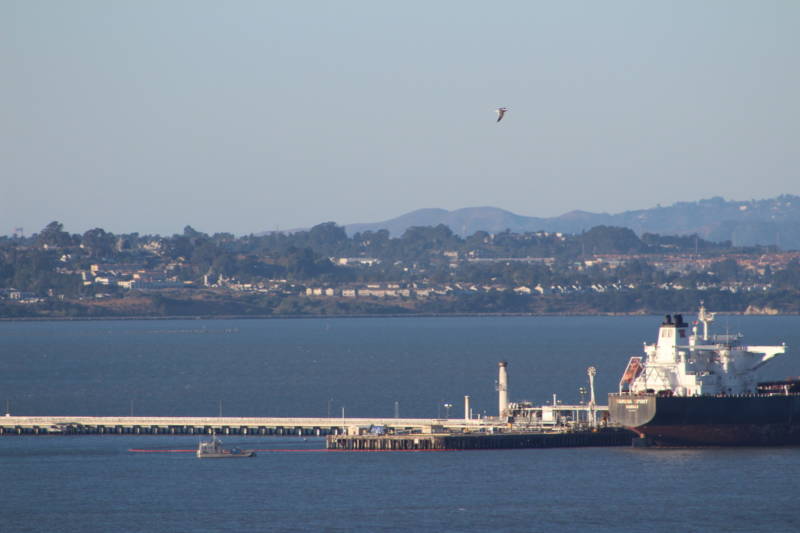The refinery and the company that own the tanker have rejected the Coast Guard's findings, which did not link the spill to the Vallejo fumes.
Kino said the district did not initially understand the magnitude of the Vallejo incident.
He said the district received only a handful of air complaints the evening of Sept. 20 and was not aware that 800 people had contacted local emergency dispatchers about the fumes. He suggested that's why the district assigned just one inspector to respond to the fumes.
"At that point I don't think it was quite known that we had such a widespread problem," Kino said, adding that if the agency had known more, it would have dispatched more inspectors.
The one inspector who responded arrived in Vallejo, a city of 118,000, about an hour after the first complaints came in.
"I would guess she was out there for an hour, maybe two hours," Kino said. The inspector couldn't detect the odor and couldn't find where it came from, he said.
The district later looked at a number of possible sources, including nearby oil refineries, a sewage plant at the base of the Carquinez Bridge, the C&H Sugar plant in Crockett and ship traffic, Kino said. The agency also checked ground-level air monitors in the area.
Eventually, district investigators zeroed in on the Phillips 66 marine terminal, a tanker that was unloading crude there at the time, pipes connecting the terminal and ship, and a vapor-recovery system at the facility. Inspectors did not find enough evidence to tie the spill to the fumes, Kino said.
State Senator Wants Answers
Kino's comments come as state Sen. Bill Dodd, who represents Vallejo, is demanding the air district provide details of its inquiry into the fumes.
"The citizens of Vallejo and Solano County deserve an explanation as to what may have happened," Dodd wrote in a letter to the district on Wednesday. "Without identifying the source, it becomes impossible to take measures to prevent or reduce risk of such an event from occurring again."
Dodd's letter also says Vallejo's Sutter Solano Medical Center declared a mass casualty incident because so many people were seeking emergency treatment at its facility. That declaration prompted ambulances to transport 20 people to other hospitals in Solano County, Dodd's letter says.
New Details on Air District's Probe
Word of Dodd's letter prompted the air district to provide more details about its investigation and explain why it has released so little information about it.
Kino said district inspectors don't normally keep records of potential sources of pollution that have been eliminated as suspected causes of a problem.
"When they're looking for an odor source, they don't necessarily document the negative of that," Kino said.
He added that much of the communication the air district had with the Coast Guard about the incident was done during in-person meetings that did not involve emails and documents.
In February, KQED requested copies of all documents and email correspondence related to the district's work on the odor and spill. District officials then said no such materials exist. An air district spokesman also told KQED its investigation into the odor was completed.
But Kino said Wednesday that documents on the incident do exist, including dozens of complaint reports about the odor and other investigative notes -- all documents the district is refusing to release.
He said the district won't release the records because the district is still investigating.
Residents, State Assemblyman, Environmentalists Demand More
People who live in Vallejo are still left without answers.
One of them is Heather Blithely, who has pressed the air district for more information on its probe and created a Facebook page called Phillips 66 Spill Vallejo.
"The fact that there's not any paper trail is shocking and disappointing," Blithely said in an interview. "I think it's really disgraceful that they didn't at least let everyone know what they didn't find."
Assemblyman Timothy Grayson, like Sen. Dodd, represents Vallejo.
"I understand and share the frustration of my constituents that we still don't have an answer as to what caused the odor," Grayson said in a statement.
The lack of information has prompted anger from two environmental groups that have followed the issue.
"It's outrageous that air district officials and other agencies failed to get to the bottom of this major oil pollution incident," said Miyoko Sakashita, the Oakland-based oceans director at the Center for Biological Diversity.
"This weak response to an oil spill that polluted our bay and sent people to the hospital underscores the dangers of shipping crude through our fragile coastal environment," Sakashita said.
"Multiple agencies have strong evidence of the source of this oil spill and the associated fumes that posed a risk to nearby residents," said Ian Wren, a staff scientist at San Francisco Baykeeper. "The failure to enforce our clean air and water laws is unacceptable."

